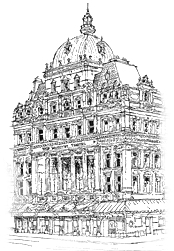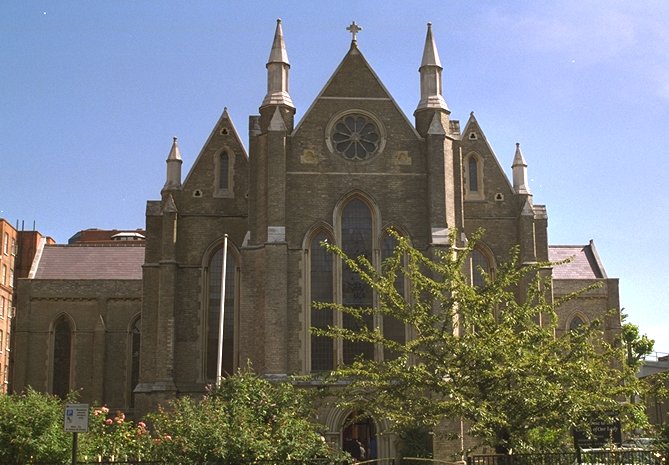
 | The Gallini Family Tree |
| Home | Contact | Statistics | Index |
Our Lady's Church
 |
The Church of Our Lady in Lisson Grove, St John's Wood, was founded by Joyce and Louisa Gallini, daughters of Sir John Gallini who came to England in the 1750s. The Gallini sisters decided in 1833 to use the bulk of their legacies from their father, who died in 1805, to endow the first Catholic Church in London after Emancipation. They chose for their architect a young man called Joseph John Stoles, who like themselves was a Catholic. The cost of building the church was £10,000. It was only after a bitter dispute had raged in England and the Vatican, involving even Pope Gregory XVI, as to whether the Jesuits or the secular clergy should service the church, that the Church of St Mary (later renamed Our Lady) in Lisson Grove was consecrated on 9th February 1836. The official Dedication which is celebrated today took place much later, on May 14th 1925. The photograph above shows the front of the church, which faces West. The two wings of the church can also be seen. The Gallini sisters lived in the South wing, the present choir transept, and the priests lived in the North wing, the present Martyrs' Chapel. The original church is described in an article - "London Catholic Churches - A Historical and Artistic Record" by Alexander Rotmann, as early English in design. The nave, with isles at each side, according to a newspaper report of 1836, had "an acutely arched and groined ceiling, which springs from moulded piers with cylindrical shafts and the groinings are ribbed." This ceiling was divided into six sections. The one at the top of the nave, which was of larger proportions, was richly ornamented with design in gold and colour. The article continued: "The aisle ceilings are as high as that of the nave and consequently there are no clerestory windows. This arrangement gives the church an original appearance.Five high lancet windows on each side are filled with stained glass in strong colours. At the top of the aisles plain walls, containing memorial tablets, open up in their upper parts into stone screened galleries of delicate construction. The side altars, being separated from the high altar by low projecting screens, formed part of the sanctuary.The high altar is built of coloured and gilt stone and marble and its reredos shows on each side of the high throne, one smaller and two larger gabled recesses. In the latter are seen stone statues of S. Richard, S. Gregory, S. Patrick and S. George. The deeply canopied throne is very delicately coloured in deep blue and gold, and this colour scheme is also applied to the canopied recesses on each side. The decoration of the frontal is quite original. The centre panel illustrates in coloured marble the meeting of Our Lord with the disciples at Emmaus, whilst the panels on each side represent, in painted marble, Jacob's sacrifice and Melchisedech. This fine frontal was carried out by the Art and Book Company. Ornamental brass and iron doors with stone arches are seen to the right and left of this altar. The large three-light pointed stained glass window above the altar was erected in memory of Canon O'Neal, the first rector of the Mission. The side altars are dedicated to Our Lady and S. Joseph and they are built of stone and marble, with a projecting canopy, supported by slender marble columns. In the centre of the Our Lady altar are carvings in alabaster showing Jacob's ladder on the left and Moses with Gideon on the right, whilst the frontal contains a group of high relief figures illustrating the gathering of the apostles at Whitsuntide. The painting over the altar is "Our Lady of good counsel". A pulpit of uncommon design stands on the ground near the communion rail. Worked in stone and marble, in a very open design, it has a figure of S. John the Baptist standing on a column with the Lamb of God in a medallion alongside. In the eastern aisle is a small altar containing a large wooden statue of S. Mary and the Infant Jesus. Of the memorial tablets, the one in the eastern wall in the Lady Chapel is worth noting. It is of Gothic design and erected to the memory of the Rev. Philip Cavanagh, a rector of the church, who died in 1880." The reminiscences of an old parishioner, Mr John McDermott, recalling 1852 and written in 1916, included the following: "In those days there was no other church in London quite like Our Lady's", and "When anyone wished to erect a memorial window, the priest in charge made it a condition that it represented one of the mysteries of the Rosary. So now we have 15 represented in our windows." At the time of the renovation the church was in touch with a Miss Mary C Gallini, and she was kept informed of the renovation plans. Miss Gallini also attended the church 150th anniversary celebrations, which I assumed, from the dates given at the beginning of this article, was in 1986. It was not clear at the time what the relationship is of this Mary Gallini to other British Gallini's, either past or present, all of whom are descended from Sir John Gallini. However, after further research, we now understand that she was probably Mary Constance Ethelfreda Gallini, daughter of John Baptist Gregory Gallini. Since she died in 1977 it would seem that the church’s 150th Anniversary celebrations were not in 1986. During renovation, which was initiated by Rev. Michael O'Dwyer who had recently taken over as parish priest, new stained glass windows were incorporated. The church now has a very modern appearance, and is very light and airy. The postal address is 54 Lodge Road, St John s Wood, NW8 8LA and you can contact the Church by phone on 020 7286 3214 |